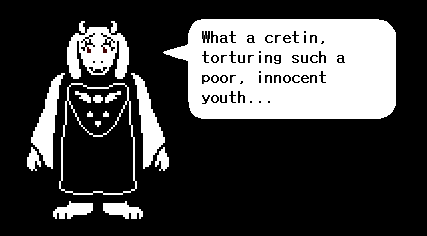It’s been a while since I last found a project that completely won me over, and I was thrilled to experience that once again with the demo of UnderTale that came out a while back. UnderTale has captivated many, and I think it’s valuable to sit back and analyse why their demo was so good. There is a lot to like, which is why this analysis will be split into several parts, so I can take my time with all of it.
Establishing themes early

After a brief intro, UnderTale starts with an extremely effective scene in which you encounter a friendly-looking flower who tells you he can help you survive in the underworld. He tells you that he’ll give you LV or “Love”, which I took to mean experience pellets. Thus far the mood is friendly and jocular.
However, the “friendliness-pellets”, as the flower called them, turn out to be damage-dealing orbs that take all your life away, and the flower proceeds to try to kill you. When he does, he changes expressions, and his demeanour becomes threatening and insulting. He surrounds us with the death-dealing pellets and tells us to die. The situation seems hopeless.

The scene is effective for several reasons. Firstly, it’s a normal trope to collect shining pellets for experience. Secondly, it’s normal for games to start off with a brief, friendly tutorial, and Undertale seemed to be going in that direction. It seems to have gone out of its way to make things friendly.

Then the flower changes not only its expression, but even its art style, turning into something horrible. Even if we expected to be betrayed by the flower (I didn’t), we certainly would not expect a sudden change in art style into something grotesque. It simply does not happen very often in games.
When the flower then turns out to want to kill us, we’re put in a surprising and completely helpless situation completely out of the blue. We haven’t even learned the game’s controls yet, and already we’ve been put in an unwinnable situation. Our trust in the game itself has been betrayed, and we feel vulnerable. We’ve been tricked! Let’s take some time to think about what’s so effective about this moment.
The moment that we are tricked
As soon as we realize that the world in the game was different than how we had predicted it to be, several things happen.
- We get off our high horse and admit that we were caught off guard. We take the narrative more seriously.
- We internally try to figure out what we did wrong that caused us to get tricked.
- We revise our expectations of the world so that we won’t fall for the same thing again.
- There is a moment where the game can capitalise on our brief confusion and introduce a highly effective dramatic event. (In this case, the flower tries to kill us immediately once we realize we were tricked.)
This is the most important moment in the demo’s intro, and for the player it passes by in a flash. As the flower taunts us and tries to kill us, the fact that it effortlessly surrounds us with the same pellets that robbed us of 49 HP and brought us down to 1 HP makes us feel completely helpless. The sequence is well choreographed and timed with loud sounds effects, changes in facial expressions and music, and is therefore highly immersive compared to what comes before and after. We are briefly given control of the hero again, just to show us that there is no escaping the flower’s attack.
This all helps to make the sequence dramatic – which is a goal in itself, but also serves to strengthen the lesson we learned in points #1, #2 and #3. And the lesson we take away from our encounter with the flower monster is that we cannot trust this world, and we cannot assume that we know anything. We are now highly motivated not to be fooled in this way the next time around.
UnderTale is aware of the fact that it has hooked us in this way, and builds on this theme of distrust.
Toriel – Escalating the themes
This is where a lot of games would try to elaborate on its themes through dialogue. Perhaps someone says something to the effect of “I don’t know how I can trust anyone anymore.”, and is forced to defend this position to some character who disagrees. Perhaps we see characters who have different takes on the subject of trust. This is not uncommon either. We’ve all seen villains who represent the negative response to some established fear. For instance, a villain who, unable to trust anyone, decides to kill all monsters, or kill all people.
UnderTale doesn’t do this, and instead does something that turns out to be (more?) interesting. Instead of presenting a solution to the problem of trust, it elaborates on the theme by presenting a more complicated relationship based on trust. That is, it hooks us on the thought of “I will not be tricked!” and then it presents a situation in which that thought can be very problematic. This is done through the introduction of Toriel.

Toriel is the mother-like creature that saves us from the flower-monster. She has long eyelashes, a friendly face, a soft voice, she is calm, polite, thoughtful, helpful, and friendly. Of course, we don’t trust her one iota.
We are led through the remaining tutorials by Toriel. The game gives us plenty of opportunities to live up to her trust or betray her trust, and no matter what we do, she treats us kindly. However, her kindness is shown to have a negative side – she doesn’t want us to fight, preferring that we talk our way out of combat situations, and she takes away our opportunities at gaining experience from enemies, scaring them away from us before we have defeated them. She also prevents us from tackling the game’s first puzzle, saying that the puzzle was still a bit too dangerous for us.
Finally, there is a sequence where she seems to have betrayed us, but it turns out she simply left us alone for a while to test our independence. She apologizes profusely, and says she has to be off to do something else. However, as we play through the game itself, she keeps in touch by phone.
In short, we are given plenty of reasons to both like and dislike Toriel’s parent-like doting on us, and this complicates the issue of trust. However, the game doesn’t stop there. Enemy combat keeps defying our expectations, as you can talk to enemies rather than defeat them. Sometimes, the best way to progress is to not fight, but rather to comfort an enemy, or cheer for them. You are led to wonder whether or not the “enemies” of enemy encounters deserve our trust. Often they do.
Breaking conventions for a reason
It’s tempting to look at Undertale and praise it primarily for the originality of its mechanics and its light-hearted style. However, I think the most crucial aspect of the game is that it uses both its style and its mechanics keep the emphasis on the theme of trust. All the puzzles and all the enemies act in surprising ways, and we cannot even trust the game’s mechanics to be unambiguous. Playing the game is an exercise in avoiding trickery – which all builds up our fear of Toriel, and what she might really be like.
This is the last crucial point that I would point out this time about UnderTale: It doesn’t break conventions simply because it can – it breaks them because breaking conventions makes us think differently. It shows that breaking convention is not something to be done for originality’s sake – it’s just another tool that can be employed to strengthen themes and guide the player’s thinking.
If there is one general game design lesson to take away from UnderTale’s excellently crafted narrative, it’s how it creates cognitive dissonance in this way. When something defies our expectations, it makes us think. Why? Because if something defies our expectations, it means we were wrong, which means there is something to think about. If you are able to predict what the confused player will be thinking, then you can, like UnderTale, tell a story where a lot of things go unsaid, by following up the thoughts that you predicted with more food for thought.
Seeing games do this well can give us insights into how best to do this – like in the case of UnderTale, which unexpectedly changes art styles and pacing to great effect, as we saw before, and which shapes the game’s mechanics around the themes it wants to communicate.
Next time I’ll look at how UnderTale’s art style, and how it simplifies effective characterization.

Good analysis. I had a hard time characterizing undertales style, but you’ve deconstructed it rather nicely. I look forward to your review on the full game.
I’ll disagree on just one bit. I think Toriel was very trustworthy very quickly, we trust almost immediately. From the plays I’ve seen it’s rare, unless they’re playing “for fun”, that they don’t trust her. Vinesauce’s Joel even calls her mother thru a Freudian Slip.